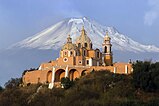
Back Puebla de Zaragoza Afrikaans مدينة بويبلا Arabic بويبلا (مدينه) ARZ Puebla de Zaragoza AST Puebla-de-Saraqosa Azerbaijani Kota Puebla BAN Puebla de Zaragoza BAR Эроіка-Пуэбла-дэ-Сарагоса Byelorussian Пуэбля-дэ-Сарагоса BE-X-OLD Пуебла Bulgarian
Puebla
Puebla de Zaragoza Puebla de los Ángeles, Cuetlaxcoapan | |
|---|---|
| Heroica Puebla de Zaragoza | |
| Nickname(s): The Reliquary of Americas, the City of Angels, The Angelopolis | |
 Location of Puebla within the state | |
 Location of the state within Mexico | |
| Coordinates: 19°02′N 98°11′W / 19.033°N 98.183°W | |
| Country | Mexico |
| State | Puebla |
| Municipality | Puebla |
| Founded | 16 April 1531 |
| Municipal status | 1821 |
| Government | |
| • Municipal President | José Chedraui Budib |
| • Secretary | Francisco Rodríguez Álvarez |
| Area | |
• Municipality | 534.32 km2 (206.30 sq mi) |
| • Urban | 68,987 km2 (269.48 sq mi) |
| Elevation (of seat) | 2,135 m (7,005 ft) |
| Population (2020) | |
• Municipality | 1,692,181 |
| • Rank | 14th in North America 5th in Mexico |
| • Density | 3,200/km2 (8,300/sq mi) |
| • Metro | 3,344,000 |
| Demonym(s) | Poblano, Angelopolitano |
| GDP (PPP, constant 2015 values) | |
| • Year | 2025 |
| • Total | $78.5 billion[1] |
| • Per capita | $46,391 |
| Time zone | UTC−6 (CST) |
| Postal code (of seat) | 72000 |
| Area code(s) | 222, 221 |
| ISO 3166 code | MX-PUE |
| Website | (in Spanish) Official site |
| Official name | Historic Centre of Puebla |
| Type | Cultural |
| Criteria | ii, iv |
| Designated | 1987 (11th session) |
| Reference no. | 416 |
| Region | Latin America and the Caribbean |
Puebla de Zaragoza (Spanish pronunciation: [ˈpweβla]; Nahuatl languages: Cuetlaxcoapan; Mezquital Otomi: Nde'ma), formally Heroica Puebla de Zaragoza, formerly Puebla de los Ángeles during colonial times, or known simply as Puebla, is the seat of Puebla Municipality. It is the capital and largest city of the state of Puebla, and the fourth largest city in Mexico, after Mexico City, Monterrey, and Guadalajara. A viceregal era planned city, it is located in the southern part of Central Mexico on the main route between Mexico City and Mexico's main Atlantic port, Veracruz—about 100 km (62 mi) east southeast of Mexico City and about 220 km (140 mi) west of Veracruz.[2]
The city was founded in 1531 in an area called Cuetlaxcoapan, which means "where serpents change their skin", between two of the main indigenous settlements at the time, Tlaxcala and Cholula.[3] This valley was not populated in the 16th century, as in the pre-Hispanic period this area was primarily used for the "flower wars" between a number of populations.[4] Due to its history and architectural styles ranging from Renaissance to Mexican Baroque, the city was named a World Heritage Site in 1987. The city is also famous for mole poblano, chiles en nogada and Talavera pottery. However, most of its economy is based on industry.[5]
Being both the fourth largest city in Mexico and the fourth largest Metropolitan area in Mexico, it has a current population of 3,344,000 people, and the city serves as one of the main hubs for eastern-central Mexico. Students from surrounding states attend its prestigious universities, such as BUAP, UDLAP, Ibero, among others. The city also excels in industry, having the world's largest Volkswagen factory outside Germany, located in the Municipality of Cuautlancingo and an Audi plant in San José Chiapa.[6] As a result, many suppliers to Volkswagen and Audi assembly plants have opened factories in the metropolitan area of Puebla.[7]
- ^ "TelluBase—Mexico Fact Sheet (Tellusant Public Service Series)" (PDF). Tellusant. Retrieved 11 January 2024.
- ^ Julia Hirshberg, "Social Experiments in New Spain: A Prosopographical Study of the Early Settlement at Puebla de Los Angeles, 1531-1534" , Hispanic American Historical Review vol. 59, 1979.
- ^ "Fundación e historia de Puebla" [Foundation and history of Puebla] (in Spanish). Mexico: El Clima. Retrieved 21 October 2009.
- ^ Barbosa Cano, Manlio (2000). "Puebla. Proceso fundacional milenario". Enlaces. 8: 5–12.
- ^ Instituto Nacional para el Federalismo y el Desarrollo Municipal (2005). "Enciclopedia de los Municipios de México ESTADO DE PUEBLA PUEBLA" [Encyclopedia of the Municipalities of Mexico State of Puebla Puebla] (in Spanish). Archived from the original on 1 December 2008. Retrieved 21 October 2009.
{{cite web}}: CS1 maint: numeric names: authors list (link) - ^ Official Volkswagen AG webpage. (In German) Archived 16 August 2011 at the Wayback Machine
- ^ Ludwig, Christopher (19 July 2016). "Volkswagen & Audi in Mexico part 2: Everything in its right place". Automotive Logistics. Retrieved 13 May 2017.










